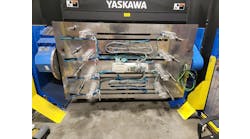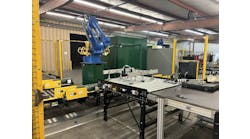The robots are coming. The robots are coming. Remember the charge that manufacturing will disappear because of this level of automation?
While a lot of the fears had been realized in the early years of robotics—welding comes to mind in the automotive industry—the current state of economics in robotic functionality has taken a turn.
Technology in this space has advanced tremendously over the past 20 years. The end effectors, which truly define the robot’s ability to perform tasks, are light years ahead of the welder grips and high pressure tongs of yesteryear.
The main issue with a robot is based in the name: a robot that performs the same repetitive task with eerie precision. The what-ifs have been dealt with using artificial intelligence (AI) to some degree, but, by and large, if the robot encounters an anomaly, it stops, unable to figure out what to do.
The original application of welding robots was to create a reduced-cost automobile frame with repeatability and take the perceived inconsistencies of manual welding out of the equation. GE Fanuc and the Karel programming language took the market by storm many years ago.
Today robotics looks so different, and they also have a different purpose. Many studies have been done on the use of robotics and their effects on manufacturing in recent years. The outcome of these studies has produced some interesting results.
Manual welding jobs have not in fact been decimated. Welding jobs are plentiful with not enough welders to fill the positions, but that goes for a lot of hands-on positions. It has been debated that the lack of versatility in a robotic welding application creates the market for an actual person.
The addition of vision however could change that metric. Robot applications have penetrated the commercial marketplace, as well, with brick-laying robots, window-washing applications and remote-controlled heavy equipment. Drones are being called robots as such, as well.
Robots are used in various aspects of manufacturing, including packaging, palletizing, sorting and the like, as well as more esoteric functions such as farming. Anywhere there is a repetitive task, a robot can be used.
However, companies are realizing that robots can work together with people with very profitable results. These are called collaborative robots, or “cobots.”
In a recent study, Statistics Canada has said companies that have an increasing number of robots are also employing an increasing number of employees.
It suggests that robotics have not been apocalyptic for labor overall. Where employees used to do the work, they have been replaced by robots, but the number of people to support the use of robotics has increased, which can also be said of most technology applied in industry.
So, the types of jobs that have been lost are where the focus has been. Even managerial jobs have been lost due to robotics since more decision-making requirements have been dropped down to the people doing the work.
This is where cobots come in. They can work in the same space as a person and have safety devices as part of their environment, so the person working with the robot is protected.
Cobots don’t operate on their own; they are collaborative. The payback on using cobots is typically less than a year, according to the Robotic Industries Association, which also states the level of employee satisfaction with their jobs is higher when a cobot is used.
The cobot becomes a friend, as such. It performs the tasks that are perhaps difficult for the employee but really easy to implement with a cobot. The level of sophistication and articulation in the cobot space is very striking.
A big advancement is in torque and force control. We have seen TV commercials where a robot picks up a small item with precision and without squashing it. Very cool and very practical.
Robots are expensive, and there is a business model out there that allows users to rent robots. Robots as a service (RaaS) has gained acceptance and market share in recent years. The pandemic has really spurred growth due to social distancing, so employees need that space, which has been taken up by cobots.
This model lowers the cost of entry for many, which would have been prohibitive for most, but the hidden gem here is that the vendor supports the hardware and software, so the user doesn’t have to. It becomes an expense on the balance sheet.
Robot technology and applications have come a long way since the first heavy-duty robots of the 1970s and 1980s. The applications of today are so varied that what is called a robot has blurred the lines of what a robot looks like.
Their functionality, however, regardless of the costumes they wear, cannot be underestimated.
Here come the robots.






